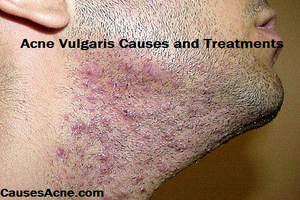
Acne Vulgaris Causes and Treatments
Being one of the most common skin diseases, acne vulgaris, affects almost all people in varying severity and forms. Acne can affect almost all areas of the body, but it most commonly affects the face and neck areas, the back and chest. The condition usually manifests during adolescence and can sometimes carry on through adulthood. The fact that this skin condition is so common has led to a large variety of treatments being offered. Some treatments are found to be more effective than others, but results for various treatments can have large variations in different people.
Causes
Acne vulgaris is caused by the blockage of follicles on the skin. Acne is most commonly found in areas with a high number of pores such as the face and upper back and chest. When the follicles are blocked, they can become inflamed and infected, causing the appearance of skin blemishes. The two things that can block follicles are dead skin cells and a naturally produced oil called sebum. Sebum is produced to help protect the skin, but when it is produced in excess it can cause skin problems such as acne.
It is generally agreed that there are four factors that cause acne in individuals. These four factors are genes, hygiene, diet and hormones.
- While proper hygiene is important in avoiding acne, it often occurs even when proper hygiene is practiced.
- Hormonal changes that come about during puberty can also cause an increased production of sebum, leading to cases of acne. The fact that acne most often occurs during adolescence is related to the hormonal effects that accompany puberty.
- It has been observed that acne is genetic and as such, the problem can occur in the family members of an individual as well.
- Foods that raise a person’s glycemic level have found to be a contributing factor in acne.
Treating Acne Vulgaris
Acne vulgaris can affect individuals at varying levels and as such the proper treatment can differ from person to person. Severity can range from a few skin blemishes to severe cases that require more serious treatment procedures. The most common treatment of acne is over the counter or non-prescription topical creams and ointments. For mild to moderate cases,� benzoyl peroxide has been found to be a useful solution. Other treatments include antibiotics, oral and topical retinoids, and hormones. Procedures are usually only used in server cases of acne that have not responded to other treatments. Some of the procedures used to treat acne include skin dermabrasion, light therapy, laser treatment and surgical lancing of cystic acne and boils.
Conclusion
While acne is not life threatening, it can cause mental issues, especially in teens and adolescents. Acne can sometimes cause permanent scarring when an excess of collagen is present in a skin blemish. When acne is treated from an early stage, scarring can be avoided. In treating acne, one must also remember to maintain proper skin care and hygiene in order to combat the disease.
